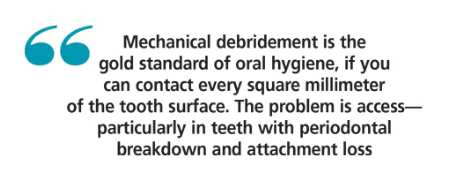Improving The Effectiveness of Self-Care Regimens
What is the best daily oral hygiene routine for patients with periodontal attachment loss?
QUESTION:What is the best daily oral hygiene routine for patients with periodontal attachment loss?
ANSWER: Successful self-care depends on the patient’s dentition, his or her unique challenges, and access. Mechanical debridement is the gold standard of oral hygiene, if you can contact every square millimeter of the tooth surface. The problem is access—particularly in teeth with periodontal breakdown and attachment loss. Floss is less effective in the mid-proximal concavities and vertical attachment deviations in areas of bone loss and pocket formation. Dental floss is effective at preventing periodontal diseases. Once tooth structure and concavities are exposed in areas of attachment loss, however, floss alone can’t remove the Gram-negative biofilm present in the deep recesses of roots.
Flexible interdental brushes are effective for accessing tight contacts and abutments of fixed dental restorations. Like floss, they can be instrumental in preventing periodontal diseases. Interdental brushes are not designed, however, to significantly disrupt biofilm that is present apically in pockets. Wooden toothpicks can be helpful in reaching mid-proximal concavities within periodontal pockets, as well as achieving oblique and vertical access into furcations. Their use may be effective for mechanical disruption in patients with periodontal breakdown, as long as access is not hampered by prosthetics.
 Powered home devices are good options for patients who are averse to flossing. They are particularly beneficial for patients with periodontal breakdown and prosthetic challenges, such as a three-unit bridge and crown contours that complicate accessibility. Both pulsating fluid and pressurized air devices have been shown to be effective at reducing interdental plaque/biofilm, with evidence-based studies to back their claims.1,2 I’ve treated many patients with excellent oral hygiene who present with chronic, nonbleeding 4 mm to 5 mm pockets that suddenly improved to 3 mm once we instituted a bleach protocol with a pulsating fluid device (1⁄2 tsp sodium hypochlorite in a full reservoir of hot water). Other antimicrobial agents used in pulsating fluid devices have also been shown to be effective.3
Powered home devices are good options for patients who are averse to flossing. They are particularly beneficial for patients with periodontal breakdown and prosthetic challenges, such as a three-unit bridge and crown contours that complicate accessibility. Both pulsating fluid and pressurized air devices have been shown to be effective at reducing interdental plaque/biofilm, with evidence-based studies to back their claims.1,2 I’ve treated many patients with excellent oral hygiene who present with chronic, nonbleeding 4 mm to 5 mm pockets that suddenly improved to 3 mm once we instituted a bleach protocol with a pulsating fluid device (1⁄2 tsp sodium hypochlorite in a full reservoir of hot water). Other antimicrobial agents used in pulsating fluid devices have also been shown to be effective.3
In the end, self-care recommendations should be based on clinical judgment (what the practitioner deems best suited for addressing the patient’s self-care challenge) and patient preference/compliance (what they will use on a consistent basis with success).
REFERENCES
- Goyal CR, Lyle DM, Qaqish JG, Schuller R. Efficacy of two interdental cleaningdevices on clinical signs of inflammation: a four-week randomized controlled trial. J Clin Dent. 2015;26:55–60.
- Genovesi AM, Lorenzi C, Lyle DM, et al. Periodontal maintenance followingscaling and root planing. A randomized single-center study comparing minocycline treatment and daily oral irrigation with water. Minerva Stomatol. January 14, 2014. Epub ahead of print.
- Wilder RS, Bray KS. Improving periodontal outcomes: merging clinical andbehavioral science. Periodontol 2000. 2016;71:65–81.
From Dimensions of Dental Hygiene. August 2016;14(08):78.

